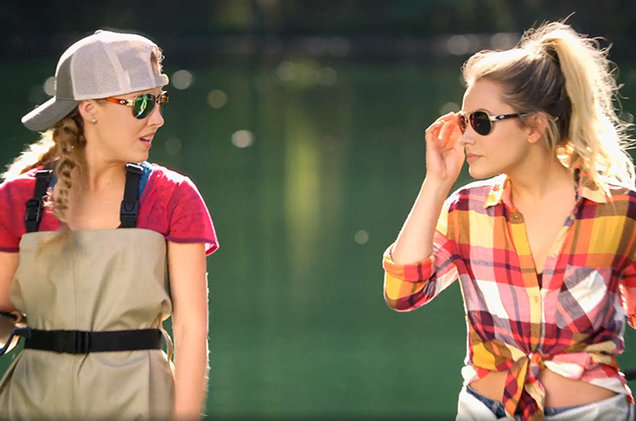The Age of the Internet Meme: Billboard Includes YouTube Data in Charts
11 years ago Liv Carter Comments Off on The Age of the Internet Meme: Billboard Includes YouTube Data in Charts
For the second time in a few months, Billboard has made a major change to its chart methodology. In October 2012, the leading music chart authority announced it was adding several new streams to the way the charts were compiled. What met with the most resistance was the inclusion of airplay on all-genre stations, a decision which instantly resulted in a Taylor Swift pop song occupying the Hot Country Songs Chart #1 spot for several weeks. I wrote about the problems the new system could inadvertently create (read: Billboard’s New Country Chart Methodology Creates Chaos), issues which have indeed cropped up.
Yesterday, Billboard announced the next phase of their overhaul and this one will really set the proverbial cat amongst the chart purist pigeons: data for YouTube will now be included. While their chart algorithm is so complex I would need Nate Silver to break it down for me in infographs, even my limited math skills are enough to figure out that this is not a good idea (yet*).
Until yesterday, the Billboard charts gathered up digital and physical single sales, tracked by Nielsen SoundScan, plus terrestrial and internet radio airplay, and on-demand audio streaming, tracked by Nielsen BDS. Given that the #1 source for music fans to discover new music is YouTube, it would seem to stand to reason that the site’s data be included. If Spotify spins are counted, why not YouTube plays?
There are two fundamental differences between the two platforms. Most obviously, while Spotify is an audio streaming service, YouTube is a video streaming service. But more importantly, I can’t rip the audio of my favorite song and add it to Spotify, while on YouTube I can. I shouldn’t (and I don’t), but I can.
The new methodology shook up the Hot 100 chart already. It provides us with the best evidence that this attempt to modernize the chart shows it has lost sight of its own mission. Debuting at #1 is Baauer’s ‘Harlem Shake,’ a song unceremoniously ignored after its June 2012 release, but suddenly thrust into the public consciousness as a fun YouTube meme. While Billboard’s chart report claims that “Baauer…has taken advantage of the digital era (and the Hot 100’s formula revision) to quickly make his hit the most popular song in the country,” I think this is a willful misrepresentation of what happened. Baauer had nothing to do with this, a fact Billboard acknowledges in the very next sentences as the article states that “[t]he track has surged thanks to the suddenly wildly popular ‘Harlem Shake’ meme. Fueled by the song’s audio as a backing track, ‘Shake’ debuts on the BDS-based Streaming Songs chart with an astounding 103 million weekly streams.” Exactly – Fueled by the song’s audio as a backing track. No one at Billboard saw the potential problem here?
Each ‘Harlem Shake’-meme video only utilizes about 35 seconds of the track, yet the video plays count towards its chart ranking. Ridiculous. Moreover, if you type in a popular artist with social media-savvy fans, like Taylor Swift, you will find thousands of fan-created videos. While many remembered to add “no copyright infringement intended” to their video, infringing copyright is absolutely what they are doing and their intent is irrelevant. Will all those videos using audio illegally also be counted? **
Billboard claims that only “official videos” and those with “authorized” audio will be counted but fails to clarify what this means. Clearly, if no user-generated videos were included, ‘Harlem Shake’ would not be sitting at #1 right now. They also report that Rihanna’s ‘Stay’ shot up from #57 to #3, and proudly add that this moves her past Whitney Houston and the Rolling Stones on the list of acts with the most Top 10 singles. The fact that Houston and the Stones achieved theirs without on-demand streaming or YouTube play should perhaps still mean something, no? Really Billboard, why are you even pretending this is comparable? This is a classic apples/oranges situation.
On the Hot Country Songs chart the effects are less dramatic but nonetheless noticeable. Hunter Hayes holds on the #1 this week with ‘Wanted,’ and Carrie Underwood‘s ‘Two Black Cadillacs’ climbs from #8 to #4 while her ‘Blown Away’ returns to the Top 10, rising from #19 to #10. Taylor Swift’s ‘We Are Never…’ also comes back, at #9 up from #14.***
Which brings me to my final point of discontent. Just like the inclusion of non-genre radio station airplay, this will mostly benefit artists who have an appeal outside of their music genre. It’s worrying for the future of the genre charts (all the genre charts, not just country) that to compete at the highest level you will have to crossover into mainstream airplay. I can’t help but feel that what Billboard is doing is rewarding artists for further homogenizing music. How long can this go on before having separate country, bluegrass, jazz, hip-hop charts no longer makes sense and you end up with one centralized chart?
What it all boils down to is that this week a song shot to #1 on the charts because someone a few weeks ago got bored and made a silly YouTube video.
* If Billboard can tighten up how data is collected so only videos posted on artists’ official channels count, maybe this will have more value.
** And I’m not even starting on all the videos that create a sensation because they’re so bad or because people are making fun of the song. See: ‘Gangnam Style.’
*** All three artists also appeared at the GRAMMY Awards so we might have to wait another week to better see the effects on the country chart.
Liv Carter
She holds several certificates from Berklee College of Music, and a certificate in Positive Psychology from UC Berkeley.
Her main influences are coffee, cats, and Alexander Hamilton.
Latest posts by Liv Carter (see all)
- Well yes, racism, but it’s more complicated - February 13, 2017
- Black River Entertainment had a great reason to party! - October 25, 2016
- Keith Urban returns to the States for US arena leg of his “ripCORD WORLD TOUR 2016” - October 10, 2016

